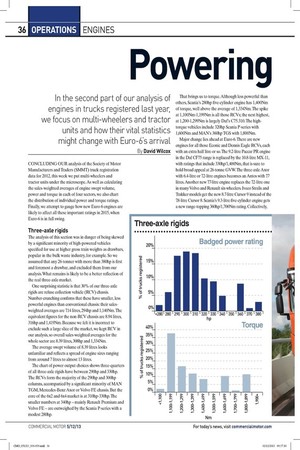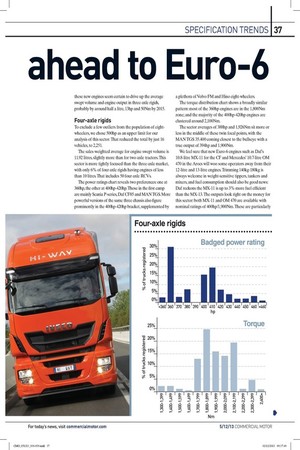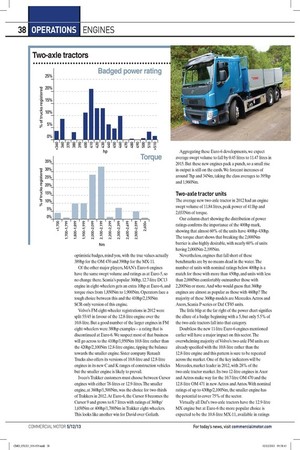Powering
Page 25

Page 26

Page 27

Page 28

If you've noticed an error in this article please click here to report it so we can fix it.
ahead to Euro 6
In the second part of our analysis of engines in trucks registered last year, we focus on multi-wheelers and tractor units and how their vital statistics might change with Euro-6's arrival By David Wilcox
CONCLUDING OUR analysis of the Society of Motor Manufacturers and Traders (SMMT) truck registration data for 2012, this week we put multi-wheelers and tractor units under the microscope. As well as calculating the sales-weighted averages of engine swept volume, power and torque in each of four sectors, we also chart the distribution of individual power and torque ratings. Finally, we attempt to gauge how new Euro-6 engines are likely to affect all these important ratings in 2015, when Euro-6 is in full swing. Three-axle rigids
The analysis of this section was in danger of being skewed by a significant minority of high-powered vehicles specified for use at higher gross train weights as drawbars, popular in the bulk waste industry, for example. So we assumed that any 26-tonner with more than 380hp is first and foremost a drawbar, and excluded them from our analysis. What remains is likely to be a better reflection of the real three-axle market.
One surprising statistic is that 30% of our three-axle rigids are refuse collection vehicle (RCV) chassis. Number-crunching confirms that these have smaller, less powerful engines than conventional chassis: their salesweighted averages are 7.14 litres, 294hp and 1,140Nm. The equivalent figures for the non-RCV chassis are 8.94 litres, 316hp and 1,419Nm. Because we felt it is incorrect to exclude such a large slice of the market, we kept RCV in our analysis, so overall sales-weighted averages for the whole sector are 8.39 litres, 308hp and 1,334Nm.
The average swept volume of 8.39 litres looks unfamiliar and reflects a spread of engine sizes ranging from around 7 litres to almost 13 litres.
The chart of power output choices shows three-quarters of all three-axle rigids have between 290hp and 330hp. The RCVs form the majority of the 290hp and 300hp columns, accompanied by a significant minority of MAN TGM, Mercedes-Benz Axor or Volvo FE chassis. But the core of the 6x2 and 6x4 market is at 310hp-330hp. The smaller numbers at 340hp — mainly Renault Premium and Volvo FE — are outweighed by the Scania P-series with a modest 280hp.
That brings us to torque. Although less powerful than others, Scania's 280hp five-cylinder engine has 1,400Nm of torque, well above the average of 1,334Nm. The spike at 1,100Nm-1,199Nm is all those RCVs; the next highest, at 1,200-1,299Nm is largely Daf's C75.310. The hightorque vehicles include 320hp Scania P-series with 1,600Nm and MAN's 360hp TGS with 1,800Nm. Major change lies ahead at Euro-6. There are new engines for all those Econic and Dennis Eagle RCVs, each with an extra half litre or so. The 9.2-litre Paccar PR engine in the Daf CF75 range is replaced by the 10.8-litre MX-11, with ratings that include 330hp/1,400Nm, that is sure to hold broad appeal at 26-tonne GVVV. The three-axle Axor with 6.4-litre or 7.2-litre engines becomes an Antos with 7.7 litres. Another new 7.7-litre engine replaces the 7.2-litre one in many Volvo and Renault six-wheelers. Iveco Stralis and Trakker models get the new 8.7-litre Cursor 9 instead of the 7.8-litre Cursor 8. Scania's 9.3-litre five-cylinder engine gets a new range-topping 360hp/1,700Nm rating. Collectively,
these new engines seem certain to drive up the average swept volume and engine output in three-axle rigids, probably by around half a litre, 13hp and 50Nm by 2015. Four-axle rigids
To exclude a few outliers from the population of eightwheelers, we chose 500hp as an upper limit for our analysis of this sector. That reduced the total by just 16 vehicles, to 2,251.
The sales-weighted average for engine swept volume is 11.92 litres, slightly more than for two-axle tractors. This sector is more tightly focused than the three-axle market, with only 6% of four-axle rigids having engines of less than 10 litres. That includes 50 four-axle RCVs. The power ratings chart reveals two preferences: one at 360hp, the other at 400hp-420hp. Those in the first camp are mainly Scania P-series,Daf CF85 and MAN TGS. More powerful versions of the same three chassis also figure prominently in the 400hp-420hp bracket, supplemented by
a plethora of Volvo FM and Hino eight-wheelers.
The torque distribution chart shows a broadly similar pattern: most of the 360hp engines are in the 1,800Nm zone; and the majority of the 400hp-420hp engines are clustered around 2,100Nm.
The sector averages of 388hp and 1,926Nm sit more or less in the middle of these twin focal points, with the MAN TGS 35.400 coming closest to the bullseye with a true output of 394hp and 1,900Nm. We feel sure that new Euro-6 engines such as Daf's 10.8-litre MX-11 for the CF and Mercedes' 10.7-litre OM 470 in the Arocs will woo some operators away from their 12-litre and 13-litre engines Trimming 140kg-180kg is always welcome in weight-sensitive tippers, tankers and mixers, and fuel consumption should also be good news: Daf reckons the MX-11 is up to 3% more fuel efficient than the MX-13. The outputs look right on the money for this sector: both MX-11 and OM 470 are available with nominal ratings of 400hp/1,900Nm. These are particularly
optimistic badges, mind you, with the true values actually 389hp for the OM 470 and 390hp for the MX-11.
Of the other major players, MAN's Euro-6 engines have the same swept volume and ratings as at Euro-5, so no change there. Scania's popular 360hp, 12.7-litre DC13 engine in eight-wheelers gets an extra 10hp at Euro-6, and torque rises from 1,850Nm to 1,900Nm. Operators face a tough choice between this and the 410hp/2,150Nm SCR-only version of this engine.
Volvo's FM eight-wheeler registrations in 2012 were split 55/45 in favour of the 12.8-litre engine over the 10.8-litre. But a good number of the larger engines in FM eight-wheelers were 380hp examples — a rating that is discontinued at Euro-6.We suspect most of that business will go across to the 410hp/1,950Nm 10.8-litre rather than the 420hp/2,100Nm 12.8-litre engine, tipping the balance towards the smaller engine. Sister company Renault Trucks also offers its versions of 10.8-litre and 12.8-litre engines in its new C and K ranges of construction vehicles but the smaller engine is likely to prevail.
Iveco's Trakker customers must choose between Cursor engines with either 7.8-litres or 12.9-litres. The smaller engine, at 360hp/1,500Nm, was the choice for two-thirds of Trakkers in 2012. At Euro-6, the Cursor 8 becomes the Cursor 9 and grows to 8.7 litres with ratings of 360hp/ 1,650Nm or 400hp/1,700Nm in Trakker eight-wheelers. This looks like another win for David over Goliath.
Aggregating these Euro-6 developments, we expect average swept volume to fall by 0.45 litres to 11.47 litres in 2015. But these new engines pack a punch, so a small rise in output is still on the cards. We forecast increases of around 7hp and 34Nm, taking the class averages to 395hp and 1,960Nm. Two-axle tractor units
The average new two-axle tractor in 2012 had an engine swept volume of 11.84 litres, peak power of 411hp and 2,033Nm of torque.
Our column chart showing the distribution of power ratings confirms the importance of the 400hp mark, showing that almost 60% of the units have 400hp-430hp. The torque chart shows that breaking the 2,000Nm barrier is also highly desirable, with nearly 60% of units having 2,000Nm-2,199Nm.
Nevertheless, engines that fall short of these benchmarks are by no means dead in the water. The number of units with nominal ratings below 400hp is a match for those with more than 450hp, and units with less than 2,000Nm comfortably outnumber those with 2,200Nm or more. And who would guess that 360hp engines are almost as popular as those with 460hp? The majority of these 360hp models are Mercedes Actros and Axors, Scania P-series or Daf CF85 units.
The little blip at the far right of the power chart signifies the allure of a badge beginning with a 5, but only 5.5% of the two-axle tractors fall into that category.
Doubtless the new 11-litre Euro-6 engines mentioned earlier will have a major impact on this sector. The overwhelming majority of Volvo's two-axle FM units are already specified with the 10.8-litre rather than the 12.8-litre engine and this pattern is sure to be repeated across the market. One of the key indicators will be Mercedes, market leader in 2012, with 28% of the two-axle tractor market. Its two 12-litre engines in Axor and Actros make way for the 10.7-litre OM 470 and the 12.8-litre OM 471 in new Actros and Antos. With nominal ratings of up to 430hp/2,100Nm, the smaller engine has the potential to cover 75% of the sector. Virtually all Daf's two-axle tractors have the 12.9-litre MX engine but at Euro-6 the more popular choice is expected to be the 10.8-litre MX-11, available in ratings
from 290hp/1,200Nm to 440hp/2,100Nm.
Two-thirds of two-axle tractors had engines of 12 litres or more in 2012. Come 2015, we anticipate that will tumble to one third. If so, that will slice 0.4 litres off the average swept volume, reducing it to just over 11.4 litres. More specifically, we reckon that 60% of the units will have engines of 10.7 litres or 10.8 litres, making this the centre of gravity at Euro-6.
Scania looks like being the main proponent of larger engines, with its 12.7-litre DC13.
The reduction in engine swept volume will not be accompanied by lower outputs. We estimate the salesweighted averages will rise by 3.5%, taking power to 425hp and torque to 2,100Nm. Three-axle tractor units
Running to more than 14,000 vehicles, the three-axle tractor unit class is the largest of the seven weight sectors we analysed. Its sales-weighted averages are as follows: swept volume is 12.35 litres; maximum power is 449hp; peak torque is 2,238Nm. Compared with two-axle units, that's 4.3% greater swept volume, 9.2% more power and 10.1% more torque.
The proportion of units with engines of 12 litres or more is also higher, at almost 80%. The real sweet spot is 12.7 litres to 12.9 litres. This narrow band captures very nearly half the entire sector.
The chart showing individual power outputs confirms that 460hp and 440hp are by far the most popular ratings at this weight, accounting for over 60% of the total. The chart also underscores how high-horsepower tractors have a disproportionately high profile. Even at this top weight, only 10% of units have nominal ratings of 500hp or more. Raising the bar to 600hp reduces that proportion to 1% and it dwindles to 0.4% at 700hp, guaranteeing the exclusivity that is part of their attraction.
The unequivocal message from our torque chart is that the peak figure really has to start with a 2. Nearly 85% have between 2,100Nm and 2,399Nm and include virtually all the big sellers. The secondary peak further up, at around 2,500Nm, is underpinned by the likes of Scania's R480,Volvo's FH500 and Daf's XF105.510.
Looking ahead, the key issue is how many operators will be convinced that Euro-6's new 11-litre engines can cut the mustard at this weight. With such a high proportion wedded to engines of 12 litres or more, it may be a hard sell.
Looking at the Euro-6 engine options for each manufacturer, we estimate that in 2015 an additional 1,500 three-axle units will be registered with engines of between 10.5 litres and 11.1 litres.
Daf and Mercedes customers choosing ratings of below 440hp or so will account for most of the new business for the smaller engines, offset by a small reduction at Renault as its new T range has the option of the 12.8-litre engine not offered in the Premium.
Reduction in average swept volume could be small because other factors pull in the reverse direction, like the disappearance of Scania's 11.7-litre engine and the extra 0.8 litres as Iveco's Cursor 10 morphs into a Cursor 11. It could boil down to a reduction of just 0.1 litres, bringing the average to 12.25 litres. Average power and torque are more likely to rise, we reckon by about 8hp and 40Nm respectively. That would take the averages up to 457hp and 2,278Nm. If all these engine forecasts turn out to be close to the mark, and manufacturers' promises of better fuel consumption also are substantiated, Euro-6 holds out the prospect of more performance for less fuel. Result. •




































